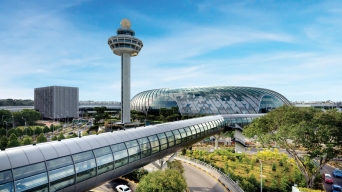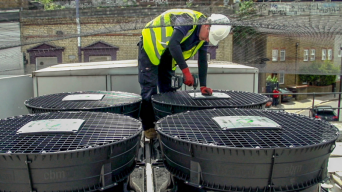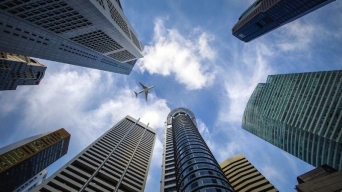Optimizing Cooling Towers in a Mall with EC Fans
Cooling Tower Fan Retrofit, Singapore
Champions of Sustainability
To stay ahead in the retail scene and meet growing customer demands, our customer implemented several sustainability initiatives. Included among these initiatives are HVAC application retrofits with EC fans. The first HVAC application to be retrofitted were air handling units, which resulted in significant energy savings. Pleased with the results, the customer continued to work with ebm‑papst to adopt further technology upgrades. In collaboration with Truwater, ebm‑papst retrofitted the cooling towers’ AC fans with EC fans after a detailed study.
AC Fan to EC Fan Retrofit for Cooling Towers
Cooling towers in a shopping mall play a vital role in removing heat from the air conditioning system by dissipating waste heat into the atmosphere. They cool water circulated through chillers, ensuring comfortable indoor temperatures and protecting HVAC equipment. A key component of this process is the cooling tower fan, which enhances airflow through the tower to maximize heat exchange. By accelerating the evaporation process, the fan significantly improves cooling efficiency. Without it, the tower’s ability to expel heat would be compromised, leading to poor chiller performance, higher energy consumption, and discomfort for mall occupants.
Existing AC fan set-up
Several cooling towers were retrofitted in this project, one of which has 3 cells. Before the fan retrofit, each cooling tower cell is equipped with a single large AC belt-driven axial fan. However, this setup presents several challenges:
- High Energy Consumption: AC fans typically consume a substantial amount of energy during operation.
- Maintenance-Intensive and Cumbersome: The belt-driven design requires frequent maintenance, and the fan’s large, bulky structure makes servicing difficult and time-consuming, often increasing labor and downtime.
- Limited Speed Control: External components, such as variable frequency drives (VFDs), are necessary to achieve variable speed control, adding complexity and cost.
- Lack of Redundancy: With only one fan per cell, a fan failure results in a complete shutdown of that cooling tower cell, as no fail-safe mechanism is in place.
- High Noise Levels: Large AC fans, especially with belt-driven mechanisms, tend to generate more noise during operation, which can be disruptive in commercial environments like shopping malls.
New EC fan set-up
The retrofit was completed efficiently, with each AC fan replaced by four EC axial fans of the AxiBlade series. This upgrade delivered several key benefits:
· Energy Efficiency: EC fans use brushless DC motors with integrated electronics, optimizing fan speed based on cooling demand. This can reduce energy consumption significantly.
· Integrated Speed Control: Built-in variable speed control eliminates the need for external VFDs, simplifying setup and improving system response.
· Reduced Maintenance: No belts or pulleys mean less wear and lower maintenance needs—especially valuable in hard-to-access tower installations.
· Compact & Easier Handling: Smaller and lighter than AC fans, EC units are easier to install and maintain in tight cooling tower spaces.
· Built-In Redundancy: Multiple EC fans per cell ensure continued operation if one fails, avoiding full system shutdowns.
· Lower Noise Levels: Quieter operation enhances comfort for nearby occupants and reduces mechanical noise complaints.
Fan Retrofit Results at a Glance
4.99 kW
pre-retrofit;
power consumed
4.15 kW
post-retrofit;
power consumed
17 %
energy savings
This retrofit significantly improved energy efficiency, reduced maintenance needs, and enhanced overall system reliability. The swift transition to EC fans has resulted in long-term cost savings and improved performance.


